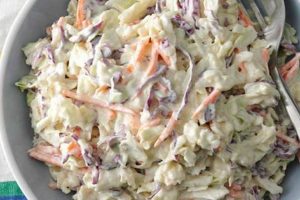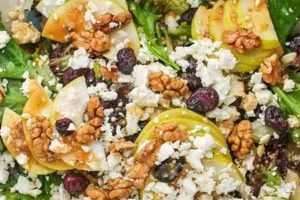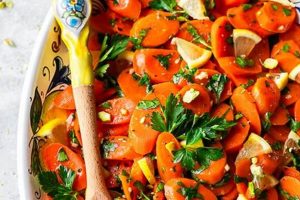A dish featuring thinly sliced or grated zucchini as the primary ingredient, often combined with other fresh vegetables, herbs, and a flavorful dressing. Variations can include ingredients like other summer squash, tomatoes, onions, corn, or cheeses such as feta or parmesan. Dressings may range from simple vinaigrettes to creamy yogurt or tahini-based sauces.
This type of dish offers a refreshing and healthy option, particularly during the summer zucchini growing season. It can serve as a light lunch, a side dish at barbecues and picnics, or part of a larger meal. The versatility of the dish lies in its adaptability to different flavor profiles and dietary needs, with opportunities for low-carb, vegan, and gluten-free variations. Historically, dishes centered around seasonal vegetables like zucchini have played a significant role in cuisines around the world, reflecting resourcefulness and culinary creativity.
The following sections explore specific preparation methods, ingredient variations, and nutritional information related to this versatile and healthful dish.
Tips for Zucchini Salad Preparation
Optimizing flavor and texture requires attention to key preparation techniques. The following tips ensure a successful and enjoyable culinary experience.
Tip 1: Salt and drain excess moisture. Salting grated or thinly sliced zucchini draws out excess water, preventing a watery salad. After salting, allow the zucchini to sit for 15-20 minutes, then gently squeeze out the liquid using a clean kitchen towel or cheesecloth.
Tip 2: Choose the right zucchini. Smaller, younger zucchini tend to be more tender and less watery than larger, more mature ones. Look for firm zucchini with vibrant skin and no blemishes.
Tip 3: Explore different cuts. Match the cut to the desired texture. Thinly sliced zucchini creates delicate ribbons, while grating produces a finer, more compact salad. Spiralizing offers a unique and visually appealing presentation.
Tip 4: Balance flavors. Combine zucchini with complementary ingredients. Acidic components like lemon juice or vinegar brighten the flavor, while fresh herbs such as mint, dill, or basil add aromatic complexity. Consider incorporating contrasting textures like toasted nuts, seeds, or crumbled cheese.
Tip 5: Dress just before serving. To maintain crispness and prevent the salad from becoming soggy, add the dressing immediately before serving.
Tip 6: Don’t overdress. Start with a small amount of dressing and add more as needed. Overdressing can weigh down the salad and dilute the flavors.
By following these guidelines, one can achieve a perfectly balanced and flavorful zucchini salad. Attention to detail in preparation ensures an optimal culinary result.
These tips facilitate the creation of a versatile and satisfying dish. The following section concludes with recipe variations and serving suggestions.
1. Ingredients
Ingredient selection significantly impacts the flavor profile, texture, and nutritional value of a zucchini salad. Careful consideration of each component ensures a balanced and satisfying culinary outcome. The primary ingredient, zucchini, provides a mild, slightly sweet base. Its neutral flavor allows for a wide range of complementary ingredients to enhance the overall taste experience. For instance, acidic ingredients like lemon juice or vinegar provide brightness and balance the zucchini’s subtle sweetness. The addition of fresh herbs, such as mint, dill, or basil, introduces aromatic complexity, while ingredients like garlic or red pepper flakes offer pungent notes. Textural contrast can be achieved by incorporating toasted nuts, seeds, or crumbled cheese. A feta and mint combination creates a Mediterranean-inspired profile, while a toasted almond and parmesan pairing provides a nutty and savory dimension.
The quality and freshness of ingredients directly correlate with the final result. Opting for locally sourced, seasonal zucchini ensures optimal flavor and nutritional content. Similarly, using fresh herbs and high-quality oils and vinegars elevates the taste and overall sensory experience. For those seeking a vegan option, nutritional yeast can replicate the cheesy flavor of parmesan, while a tahini-based dressing provides a creamy, dairy-free alternative. Adapting ingredients to accommodate dietary restrictions or preferences exemplifies the versatility of this dish.
Understanding the interplay of ingredients within a zucchini salad allows for creative customization and flavor exploration. Balancing flavors, textures, and nutritional considerations yields a dish that is not only delicious but also reflects culinary intentionality. This knowledge empowers individuals to create personalized variations tailored to specific tastes and dietary needs, maximizing enjoyment and nutritional benefit.
2. Preparation
Preparation methods significantly influence the final quality and enjoyment of a zucchini salad. Careful execution of specific techniques ensures optimal texture, flavor development, and overall palatability. The inherent water content of zucchini necessitates addressing excess moisture. Salting and draining the zucchini prior to incorporating other ingredients prevents a watery salad and allows the dressing to adhere effectively. This step enhances the overall texture and prevents dilution of flavors.
The choice of cutting technique further impacts the salad’s character. Thinly slicing creates delicate ribbons suitable for lighter, more elegant presentations. Grating, conversely, yields a finer texture, ideal for salads with a denser consistency. Spiralizing offers a visually appealing option and a unique textural experience. Matching the cutting technique to the desired outcome demonstrates culinary intentionality and contributes to a more satisfying dining experience. For example, a salad featuring thinly sliced zucchini and a light vinaigrette benefits from the delicate texture and allows the subtle flavors to shine. A grated zucchini salad with a more robust dressing, on the other hand, requires a heartier texture to balance the stronger flavors.
Precise execution of preparatory steps ensures the realization of a successful zucchini salad. Addressing moisture content through salting and draining and selecting appropriate cutting techniques contribute significantly to the final product’s textural and flavor profile. Understanding these foundational principles empowers one to create a dish that not only meets but exceeds culinary expectations. Neglecting these key steps can result in a watery, less flavorful salad, underscoring the direct correlation between preparation and outcome. This knowledge facilitates the creation of consistently delicious and visually appealing zucchini salads tailored to individual preferences and desired culinary outcomes.
3. Flavor Profiles
Flavor profiles play a crucial role in defining the character of a zucchini salad. Understanding how different ingredients interact allows for the creation of a balanced and harmonious dish. The mild flavor of zucchini provides a versatile canvas for a wide range of flavor combinations, from bright and herbaceous to rich and savory.
- Bright and Citrusy
This profile emphasizes fresh, zesty flavors. Lemon juice, lime juice, or orange zest provide acidity, while fresh herbs like mint, dill, or parsley contribute herbaceous notes. Feta cheese can complement the citrus and herbs, creating a Mediterranean-inspired salad. This profile is particularly refreshing during warmer months.
- Savory and Nutty
Toasted nuts, such as almonds, walnuts, or pine nuts, add richness and complexity to zucchini salads. Parmesan cheese, nutritional yeast, or toasted sesame seeds enhance the savory notes. A balsamic vinaigrette or a tahini-based dressing complements these flavors well. This profile offers a more substantial and satisfying salad experience.
- Spicy and Tangy
Ingredients like chili flakes, jalapeos, or a sriracha-based dressing introduce heat and complexity. Lime juice or rice vinegar provide tanginess, while cilantro or Thai basil add fresh, aromatic notes. This profile offers a vibrant and flavorful option for those who enjoy bolder tastes.
- Earthy and Herbaceous
This profile focuses on earthy flavors and aromatic herbs. Roasted garlic, mushrooms, or sun-dried tomatoes add depth, while herbs like oregano, thyme, or rosemary contribute savory notes. A red wine vinaigrette or a lemon-herb dressing complements these flavors effectively. This profile provides a more robust and grounding salad option.
The versatility of zucchini allows for exploration of diverse flavor profiles, catering to a wide range of palates and culinary preferences. By understanding the interplay of different ingredients and flavor components, one can create zucchini salads that are not only delicious but also reflect culinary creativity and intentionality.
4. Presentation
Presentation elevates a zucchini salad from a simple dish to a visually appealing culinary creation. Thoughtful plating enhances the dining experience, engaging multiple senses and increasing perceived value. Consideration of color, texture, and arrangement transforms the salad into an aesthetically pleasing and appetizing presentation.
- Color and Contrast
Visual appeal begins with color. The vibrant green of zucchini provides a base upon which to build a visually engaging presentation. Incorporating ingredients with contrasting colors, such as bright red tomatoes, deep purple onions, or golden corn kernels, creates a dynamic and appetizing appearance. The interplay of colors stimulates visual interest and enhances the overall dining experience.
- Texture and Height
Varying textures add another dimension to the presentation. Combining thinly sliced zucchini ribbons with crumbled cheese, toasted nuts, or crunchy seeds creates textural contrast. Building height within the salad, rather than presenting a flat, uniform layer, adds visual interest. A mound of spiralized zucchini topped with a sprinkle of herbs and a drizzle of dressing provides a more dynamic and engaging presentation.
- Plating and Garnishing
The choice of serving dish and garnishes further enhances the presentation. A simple white plate provides a clean backdrop that allows the colors of the salad to stand out. Alternatively, a rustic wooden bowl can create a more casual and inviting feel. Garnishes, such as a sprig of fresh herbs, a sprinkle of spice, or a drizzle of dressing, add a finishing touch and enhance the visual appeal.
- Context and Occasion
The presentation should also consider the context of the meal. A casual lunch might call for a simple, rustic presentation, while a more formal dinner might warrant a more refined and elegant approach. Adapting the presentation to the occasion demonstrates attention to detail and enhances the overall dining experience. A family-style serving bowl works well for a casual gathering, while individual portions plated artfully elevate a more formal setting.
Thoughtful presentation elevates the zucchini salad from a simple side dish to a visually captivating culinary experience. Attention to color, texture, plating, and context demonstrates culinary expertise and enhances the overall enjoyment of the dish. These considerations transform the salad into a feast for the eyes as well as the palate.
5. Nutritional Value
Nutritional value represents a significant factor in the appeal of zucchini salads. Zucchini, a low-calorie vegetable rich in vitamins and minerals, provides a nutritious foundation for this culinary creation. A single cup of raw zucchini contains a substantial amount of Vitamin C, contributing to immune function and antioxidant protection. It also offers Vitamin K, crucial for blood clotting and bone health, and Vitamin B6, supporting brain development and function. Furthermore, zucchini provides essential minerals such as potassium, manganese, and magnesium. Potassium plays a vital role in regulating blood pressure, while manganese and magnesium contribute to metabolic processes and overall well-being. The inclusion of other fresh vegetables and herbs in the salad further amplifies its nutritional density. For example, adding bell peppers introduces Vitamin A and additional Vitamin C, while leafy greens like spinach contribute folate and iron. The nutritional profile can be further enhanced by incorporating protein sources such as grilled chicken, fish, or legumes.
The preparation method influences the overall nutritional value. Minimally processed ingredients retain more nutrients. Opting for raw zucchini, when appropriate, maximizes the availability of heat-sensitive vitamins. Light cooking methods, such as steaming or grilling, preserve more nutrients compared to boiling or frying. The choice of dressing also plays a role. Vinaigrettes made with healthy oils, like olive oil or avocado oil, provide beneficial monounsaturated fats and enhance the absorption of fat-soluble vitamins. Limiting the use of processed dressings high in saturated fats, added sugars, and sodium helps maintain the salad’s nutritional integrity. A simple lemon-herb vinaigrette, for instance, not only provides a light and flavorful dressing but also reduces the intake of unnecessary calories and additives. Conversely, creamy dressings, while flavorful, can contribute significantly more calories and fat.
Understanding the nutritional composition of a zucchini salad allows for informed dietary choices. Consuming nutrient-rich foods supports overall health and well-being. Incorporating zucchini salads into a balanced dietary pattern contributes to meeting recommended daily intakes of essential vitamins, minerals, and fiber. This knowledge empowers individuals to make health-conscious decisions and maximize the nutritional benefits derived from this versatile and flavorful dish. Zucchini salads can play a valuable role in weight management due to their low calorie density and high fiber content, promoting satiety and aiding in portion control. Recognizing the nutritional advantages of this dish allows for its strategic inclusion in dietary plans aimed at improving overall health and wellness.
Frequently Asked Questions
This section addresses common inquiries regarding the preparation and enjoyment of zucchini salads. Clarification on these points aims to facilitate successful culinary experiences.
Question 1: How can excess moisture in zucchini be managed when preparing a salad?
Salting the zucchini and allowing it to sit for 15-20 minutes draws out excess water. Gently pressing the zucchini with a clean kitchen towel or cheesecloth further removes moisture, preventing a watery salad.
Question 2: What are the optimal storage methods for a prepared zucchini salad?
Storing the salad and dressing separately maximizes shelf life and maintains optimal texture. Refrigerate components in airtight containers and combine just prior to serving. Consume within 2-3 days for optimal freshness.
Question 3: Can zucchini salads be prepared in advance for events or gatherings?
Advance preparation is possible; however, to maintain optimal texture and prevent sogginess, it is recommended to prepare components separately and combine them immediately before serving. Dress the salad at the last minute.
Question 4: What are suitable substitutes for zucchini in a zucchini salad?
While zucchini forms the base of this specific salad, similar summer squash varieties, such as yellow squash or pattypan squash, can be substituted or incorporated alongside zucchini. Cucumber offers a refreshing alternative with a similar textural profile.
Question 5: What are some effective methods for incorporating protein into a zucchini salad?
Grilled chicken, shrimp, or fish complement zucchini well. Chickpeas, lentils, or cannellini beans provide plant-based protein options. These additions create a more substantial and satisfying meal.
Question 6: How can one adjust the flavor profile of a zucchini salad to accommodate dietary restrictions or preferences?
Flavor profiles can be easily adapted. Vegan options can utilize nutritional yeast in place of cheese and incorporate plant-based dressings. Gluten-free adaptations focus on ensuring all ingredients, including dressings and toppings, are gluten-free. Specific herbs, spices, and flavor combinations can cater to individual preferences, such as omitting garlic or adding chili flakes for spice.
Addressing these common questions clarifies key aspects of zucchini salad preparation and enjoyment. Attention to these details ensures a successful culinary experience.
The subsequent sections offer detailed recipes and serving suggestions for further exploration.
Conclusion
Exploration of this culinary subject reveals a dish offering versatility, nutritional value, and culinary creativity. From ingredient selection and preparation techniques to flavor profiles and presentation, each aspect contributes to the final outcome. Emphasis on freshness, proper handling of zucchini’s water content, and balanced flavor combinations ensures a successful and enjoyable culinary experience. Adaptability to diverse dietary needs and preferences further enhances the dish’s appeal.
Culinary exploration extends beyond mere sustenance; it represents a journey of discovery and an opportunity to connect with fresh, seasonal ingredients. This dish serves as a canvas for culinary expression, inviting experimentation with flavors, textures, and presentations. Continued exploration of culinary possibilities enriches not only individual experiences but also contributes to a broader appreciation for the art of food preparation and the vital role fresh produce plays in a healthy and vibrant lifestyle.






